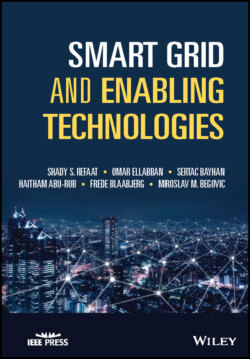Читать книгу Smart Grid and Enabling Technologies - Frede Blaabjerg - Страница 41
1.7.4 Demand Response Support
ОглавлениеSG permits generators and loads to interrelate in an automated way in real‐time, which allows customers to play a major role in optimizing the operation of the whole grid. Also, giving the consumers timely information enables them to reduce their energy bills by modifying their consumption patterns to overcome some of the constraints in the power system. DR and DSM are essential programs in SGs. DSM is applied for long‐term planning such as for shifting the load peak over time. DR ensures short‐term load response to improve the energy consumption profile over time. This could be realized by creating a dynamic electricity price. Consumers have the choice and authority over their consumption patterns. Various financial incentives could be created to adjust the level of demand and generation at strategic periods of the day. Figure 1.16 presents a classification of DR programs. Implementing DR programs into the operational aspects of the system has different benefits such as reducing the peak load and avoiding the need for new power plants and infrastructure oversizing [46].
DR programs are categorized into two main programs, time‐based programs, and incentive‐based programs. In the time‐based DR programs, the change in electricity prices can vary automatically at different times based on customer electricity consumption as per the contracts signed with the operator. While, with the incentive‐based DR programs, the customer is offered some incentives to participate in a fixed or varying period. The benefits will increase by triggering an incentive price to affect customer behavior by decreasing demand consumption.
Figure 1.16 Classification of DR.
Currently, DR is only used by large commercial consumers, and its operation is based on informal signals such as phone calls by the utility or by the DR provider asking the consumer to lower their energy consumption during peak times for energy demand [47]. There are four main obstacles in the face of the uptake of DR:
1 The shortfall of market integration.
2 Improving incentive‐based DR programs.
3 The need for increased adoption of enabling technologies.
4 More communication in the power grid which is associated with privacy and security concerns.
